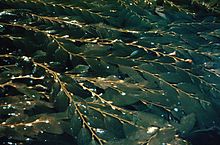
| |
| Names | |
|---|---|
| Other names
Alginic acid; E400; [D-ManA(β1→4)L-GulA(α1→4)]n
| |
| Identifiers | |
| ChemSpider |
|
| ECHA InfoCard | 100.029.697 |
| EC Number |
|
| E number | E400 (thickeners, ...) |
| UNII | |
CompTox Dashboard (EPA)
|
|
| Properties | |
| (C6H8O6)n | |
| Molar mass | 10,000 – 600,000 |
| Appearance | White to yellow, fibrous powder |
| Density | 1.601 g/cm3 |
| Acidity (pKa) | 1.5–3.5 |
| Pharmacology | |
| A02BX13 (WHO) | |
Except where otherwise noted, data are given for materials in their standard state (at 25 °C [77 °F], 100 kPa).
| |

Alginic acid, also called algin, is a naturally occurring, edible polysaccharide found in brown algae. It is hydrophilic and forms a viscous gum when hydrated. When the alginic acid binds with sodium and calcium ions, the resulting salts are known as alginates. Its colour ranges from white to yellowish-brown. It is sold in filamentous, granular, or powdered forms.
It is a significant component of the biofilms produced by the bacterium Pseudomonas aeruginosa, a major pathogen found in the lungs of some people who have cystic fibrosis.[1] The biofilm and P. aeruginosa have a high resistance to antibiotics,[2] but are susceptible to inhibition by macrophages.[3]
Alginate was discovered by British chemical scientist E. C. C. Stanford in 1881, and he patented an extraction process for it in the same year.[4] The alginate was extracted, in the original patent, by first soaking the algae in water or diluted acid, then extracting the alginate by soaking it in sodium carbonate, and finally precipitating the alginate from solution.[5][better source needed]
- ^ Davies, JC (2002). "Pseudomonas aeruginosa in cystic fibrosis: pathogenesis and persistence". Paediatric Respiratory Reviews. 3 (2): 128–34. doi:10.1016/S1526-0550(02)00003-3. ISSN 1526-0542. PMID 12297059.
- ^ Boyd, A; Chakrabarty, AM (1995). "Pseudomonas aeruginosa biofilms: role of the alginate exopolysaccharide". Journal of Industrial Microbiology. 15 (3): 162–8. doi:10.1007/BF01569821. ISSN 0169-4146. PMID 8519473. S2CID 42880806.
- ^ Leid, JG; Willson, CJ; Shirtliff, ME; Hassett, DJ; Parsek, MR; Jeffers, AK (1 November 2005). "The exopolysaccharide alginate protects Pseudomonas aeruginosa biofilm bacteria from IFN-gamma-mediated macrophage killing" (PDF). Journal of Immunology. 175 (11): 7512–8. doi:10.4049/jimmunol.175.11.7512. ISSN 0022-1767. PMID 16301659. S2CID 1011606.
- ^ Cite error: The named reference
extractwas invoked but never defined (see the help page). - ^ Pereira, Leonel; Cotas, João (2020-02-05), "Introductory Chapter: Alginates - A General Overview", Alginates - Recent Uses of This Natural Polymer, IntechOpen, ISBN 978-1-78985-642-2, retrieved 2024-08-06